Arithmetic Chapter 2 Profit And Loss
Arithmetic Chapter 2 What is Cost Price?
Cost Price:-
- The price at which an article is bought is called the cost price of that article.
- For example, let you have bought a pen for ₹ 10.
- Then the selling price of the pen is ₹ 10.
- Or let, you have bought a book for ₹ 60, then the cost price of the book is ₹ 60.
- We generally calculate profit and loss on the basis of cost price in any business.
- Sometimes, there are some goods, which are manufactured or produced in the factories, such as soaps, toothpaste, toothbrush, etc.
- In these cases, there are no-cost prices of the goods, but we consider their production costs.
- The article is called its production cost.
- So, the cost is required to produce For example, if the cost to produce a soap is ₹ 12, then the production cost of the soap is ₹ 12.
- In these cases, the profit and loss are usually calculated on the basis of production cost.
- Moreover, when an article is bought, then it is obvious that someone sells it.
- So, the cost price of an article may be the selling price in some other context, i.e. to any person which is the cost price, to another person it is the selling price.
- So, in any mathematical problem, we should be very careful that just which price has been described as the cost price.
- But, in general, the price at which an article is bought is called its cost price.
Read and Learn More WBBSE Solutions For Class 9 Maths
Arithmetic Chapter 2 What is Selling Price
Selling Price
- The price at which an article is sold is called its selling price ($.P.).
- For example, let you have sold a clock to Surjya at ₹ 250.
- So, the selling price of the clock is ₹ 250.
- Or, if you have sold a radio to Ananya at ₹ 400, then the selling price of the radio is ₹ 400.
- Now, the selling price of an article may or may not be more than its cost price.
- For, let the pen you have bought for ₹ 10, has sold to Ganesh at ₹ 12.
- Then, here the selling price is more than the cost price.
- When you will sell the pen to Ganesh at ₹ 8, the selling price will be less than the cost price.
To solve any mathematical problem regarding profit and loss, you should have to keep a keen sight of the following:
- What is the cost price and which is the selling price? Because, if these two prices are known, then it is easy to solve any problem regarding profit and loss.
- If these two prices are not given directly, then try to find them by any other mathematical process.
- It is impossible to calculate profit or loss if the cost price of an article and the selling price of another article are given.
- So it is clear that the selling price of that article, which has been just bought, should be found out.1. For example, what is the percentage of profit or loss, when Bananas are bought at the rate of 6 per ₹ 1 and sold at the rate of 5 per ₹ 1? Here, the number of Bananas is 6 when it is bought, but the number is 5 when it is sold. So, it is difficult to calculate the profit or loss.2. So, if the number of Bananas is 6 when it is bought, the number of Bananas must be 6 when it is sold.3. That is, the number of Bananas both bought and sold must be the same.
Arithmetic Chapter 2 What Is Profit
Profit:-
You have already heard that the selling price of an article may or may not be more than its cost price, i.e., Cost price < Selling price or Cost price > Selling price.
If the selling price is more than the cost price (Selling price > Cost price), then we say that profit has been generated, and to what extent the selling price is more than the cost price is called the profit. Therefore, if the selling price of an article is more than its cost price, then the difference between the two prices is called a Profit or Gain.
Mathematically, Profit = (S.P.) – (C.P.)……..(1)
For example, let you have bought 1 kg of sugar for 40 and have sold it at ₹ 45.
Then, the profit = (₹ 45 – ₹ 40)
= ₹ 5.
Corollary:
From the formula (1), we get
(1) C.P. = S.P. – Profit…….[1. (1)]
(2) S.P. = C.P. + Profit……..[1. (2)]
For example, Sarmistha gains ₹ 20 by selling a shirt for ₹ 120.
Here, S.P. = ₹ 120 and Gain = ₹ 20.
Hence, by the formula [1 (1)],
the C.P. of the article = S.P. – Gain (₹ 120 – ₹ 20) = ₹ 100
Again let, Gargi sells a soap with a gain of 2 by buying it at ₹ 50.
Here, C.P. = ₹ 50 and Gain = ₹ 2.
∴ By the formula 1 (2), the S.P. of the soap
= C.P. + Gain = (₹ 50 + ₹ 2) = ₹ 52.
Arithmetic Chapter 2 What is Loss
Loss:-
You know that the selling price of an article may or may not be less than its cost price.
If the selling price is less than its cost price, then we say that a Loss has been generated.
Therefore, if the selling price of an article is less than its cost price, then the difference between the two prices is called a Loss.
Mathematically, Loss = (C.P.) – (S.P.) ……. (2)
For example, let Moetreyee buys 14 pencils for 40 and sells all of them, at ₹ 36.
Here, C.P. = ₹ 40 and S.P. = ₹ 36.
∴ Loss (C.P.) – (S.P.)
= (₹ 40 – ₹ 36)
= ₹ 4.
Corollary:
From the formula (2), we get
(1) C.P. = S.P. + Loss……[2. (1)]
(2) S.P. = C.P. – Loss……[2. (2)]
For example, let Arunima sells a packet of tea with a loss of 8 by buying it for 68.
Here, C.P. = ₹ 68 and Loss =₹ 8.
∴ By the formula [2. (2)],
S.P. C.P. Loss (₹ 68 – ₹ 8) = ₹ 60.
Again let, Debdulal lose ₹ 7 by selling a C.D. at ₹ 25.
Here, S.P = ₹ 25 and Loss = ₹ 7.
∴ By the formula 2. (1), C.P. = S.P. + Loss = (₹ 25 + ₹ 7) = ₹ 32.
Arithmetic Chapter 2 Rate of Profit and Loss
After buying and selling an article, we have to calculate usually two rates
1. Rate of Profit:
It is a vital question that exactly what the rate of profit is.
Because there are different types of rates.
Such as, rate w.r.t. 10, rate w.r.t. 100, rate w.r.t. 1000, ….. etc.
In this book, we are clearly interested in the rate w.r.t. 100, i.e., we want to find the percentage of profit or the profit percent.
Now, the percentage of Profit or the Profit percent means the units of Profit generated by 100 units of the article concern.
Thus, the percentage of Profit = a % means that a unit of Profit has been generated by 100 units of the article.
Similarly, it means that a is the profit when the C.P. is 100, or, a kg is the profit when the total amount of the article is 100 kg.
Therefore,
1. Percentage of Profit on C.P. = \(\frac{\text { Total Profit }}{\text { C.P. }} \times 100 \%\) …………………(3)
2. Percentage of Profit on S.P. = \(\frac{\text { Total Profit }}{\text { S.P. }} \times 100 \%\) ………………(4)
If the total profit is not given, only the C.P. and S.P. are given, then
2. Percentage of Profit on C.P. = \(\frac{\text { S.P.-C.P. }}{\text { C.P. }} \times 100 \%\) ……………..(5)
3. Percentage of Profit on S.P. = \(\frac{\text { S.P.-C.P. }}{\text { C.P. }} \times 100 \%\)……………..(6)
Corollary:
1. C.P. = \(\frac{\text { Total Profit }}{\text { Percentage of Profit }} \times 100 \%\) ………….. [3. (1)]
For example, Gitadevi gains 40 by selling a clock at a profit of 10%, find the C.P. of the clock.
Here, Total Profit = 40 and Percentage of Profit = 10%.
∴ By 3. (1) we get,
C.P. = \(\frac{\text { Total Profit }}{\text { Percentage of Profit }} \times 100 \%\)
= \(\frac{₹ 40}{10 \%} \times 100 \%\)
= (40) x 10
= 400
2. S.P. = \(\frac{\text { Total Profit }}{\text { Percentage of Profit }} \times 100 \%\) ……………[4.(1)]
For Example,
For example, Sankarbabu gains ₹ 24 by selling a radio at a profit of 4% on S.P. What is the S.P. of the radio?
Here, percentage of Profit = 4% and Total Profit = ₹ 24
∴ By 4. (1), we get, S.P. = \(\frac{\text { Total Profit }}{\text { Percentage of Profit }} \times 100 \%\)
= \(\frac{₹ 24}{4 \%} \times 100 \%\)
= (₹ 24) x 25
= ₹ 600.
3. C.P. = \(\) ……………[5(1)]
For example, Santidevi sold a blanket at ₹ 440 at a profit of 10%. What is the C.P. of the blanket? Here, S.P. ₹ 440 and Percentage of Profit = 10%
∴ By 5. (1) we get, C.P.= \(\frac{\text { S.P. }}{\text { Percentage of Profit }+100 \%} \times 100 \%\)
= \(\frac{₹ 440}{10 \%+100 \%} \times 100 \%\)
= \(\frac{₹ 440}{110 \%} \times 100 \%\)
= \(₹ \frac{440 \times 10}{11}\)
= ₹ 400.
4. S.P.= \(\frac{\text { C.P. }}{100 \%-\text { Percentage of Profit }} \times 100 \%\)…………………[6(1)]
For example, Shyambabu sold a bicycle to Pabanbabu by buying it for ₹ 980 and gained 2% on S.P. What was the S.P. of the bicycle?
Here, C.P. = ₹ 980 and Percentage of Profit
= 2% (on S.P.)
∴ by 6. (1) we get, S.P. = \(\frac{\text { C.P. }}{100 \%-\text { Percentage of Profit }} \times 100 \%\)
= \(\frac{₹ 980}{100 \%-2 \%} \times 100 \%\)
= \(\frac{₹ 980}{98 \%} \times 100 \%\)
= ₹ (10 x 100)
= ₹ 1000.
2. Rate of Loss:
Rate of Loss means out of what units, how many units have been lost.
If the unit in the given problem is then the term Percentage of Loss means that out of ₹ 100, how many?
have been lost ₹ When the unit is kg, then it means that out of ₹100 kg, how many kg have been lost ₹ Thus, Total Loss C.P. Total Loss S.P.
1. Percentage of Loss on C.P.= \(\frac{\text { Total Loss }}{\text { C.P. }} \times 100 \%\)………………..(7)
2. Percentage of Loss on S.P.= \(\frac{\text { Total Loss }}{\text { S.P. }} \times 100 \%\)…………..(8)
If the total loss is not given, only the C.P. and S.P. are given, then
3. Percentage of Loss on C.P.= \(\frac{(\text { C.P. })-(\text { S.P. })}{\text { C.P. }} \times 100 \%\) ……………….(9)
4. Percentage of Loss on S.P. = \(\frac{(\text { C.P. })-(\text { S.P. })}{\text { S.P. }} \times 100 \%\) …..…………..(10)
Corollary:
1. C.P. = \(\frac{\text { Total Loss }}{\text { Percentage of Loss }} \times 100 \%\) ………..[7(1)]
For example, Prasantababu sold a T.V. with a loss of 200 at a loss of 10%. What is the C.P. of the T.V.?
Here, the total loss = ₹ 200 and the percentage of loss = 10%
∴ By 7 (1) we get, C.P.= \(\frac{\text { Total Loss }}{\text { Percentage of Loss }} \times 100 \%\)
= \(\frac{₹ 200}{10 \%} \times 100 \%\)
= ₹ 2000.
2. S.P.= \(\frac{\text { Total Loss }}{\text { Percentage of Loss }} \times 100 \%\) ……….[8(1)]
For example, Swapanbabu sold a goat with a total loss of ₹ 225 at a loss of 15% on S.P.
Find the S.P. of the goat.
Here, the percentage of loss is 15%, and the Total loss = ₹ 225.
∴ by 8 (1) we get, S.P.= \(\frac{\text { Total Loss }}{\text { Percentage of Loss }} \times 100 \%\)
= \(\frac{₹ 225}{15 \%} \times 100 \%\)
= ₹ 1500.
3. C.P.= \(\frac{\text { S.P. }}{100 \% \text {-Percentage of loss }} \times 100 \%\) ……………..[9(1)]
For example, Ranjan Kumar sold an article at 2400 at a loss of 20% on S.P. What is the C.P. of the article?
Here, S.P. 2400 and Percentage of loss = 20% on S.P.
∴ by 9 (1) we get, C.P.= \(\frac{\text { S.P. }}{100 \% \text {-Percentage of loss }} \times 100 \%\)
= \(\frac{₹ 2400}{100 \%-20 \%} \times 100 \%\)
= \(\frac{₹ 2400}{80 \%} \times 100 \%\)
= ₹ 3000.
4. S.P.= \(\frac{\text { C.P. }}{\text { Percentage of loss }+100 \%} \times 100 \%\) ………..[10(1)]
For example, Bimanbabu bought a book for 1000 and sold it to his colleague.
This causes him a loss of 25% on S.P. What is the S.P. of the book?
Here C.P. = ₹ 1000 and Percentage of loss = 25%
. by 10 (1) we get, S.P. = \(\frac{\text { C.P. }}{\text { Percentage of loss }+100 \%} \times 100 \%\)
= \(\frac{₹ 1000}{25 \%+100 \%} \times 100 \%\)
= \(\frac{₹ 1000}{125\%} \times 100 \%\)
=₹ 800
Arithmetic Chapter 2 What is meant by the market price
Market Price:-
The price which is marked on an article is called the Marked Price (M.P.) or List price of that article.
For example, let the price of a book has been typed 75.
Then the marked price (M.P.) or the list- the price of the book is 75.
Arithmetic Chapter 2 Discount
Discount:-
A seller may or may not sell his article at the marked price or list price. If he sells his article at a price less than the marked price, then the less price at which the article is sold is called the discount.
Therefore, the less price or the deduction price from the marked price, at which any article is sold to the customers, is called the discount.
For example, Mantubabu sells a book of marked price ₹120 at ₹100.
Then the discount = ₹ (120-100)
= ₹ 20.
∴ Discount = (M.P.) – (S.P.)………….(11)
Corollary:
M.P. = S.P. + Discount …….. [11. (1)]
S.P. = M.P. – Discount ……….. [11. (2)]
For examples.
1. Anjanbabu sells a book at ₹ 105 with a discount of ₹ 35.
What is the M.P. of the book?
Here S.P. ₹105 and Discount = ₹35.
∴ M.P. of the book = S.P. + Discount [by 11. (1)]
= ₹ 105 + ₹ 35
= ₹140.
2. Udaynarayan Chowdhury allows a discount of ₹ 800 while selling a blanket of marked price ₹ 8400.
What is the S.P. of the blanket?
Here M.P. ₹ 8400 and Discount = ₹ 800.
∴ S.P. of the blanket = (M.P.) – Discount [by 11. (2)]
= ₹ 8400
= ₹ 800
= ₹ 7600.
Generally, the discounts are given in the form of percentages, such as 2% discount, 10% discount, 25% discount,…… etc.
In these cases, the percentage of discount = \(\frac{\text { Total discount }}{\text { M.P. }} \times 100 \%\) ……….(12)
and Total discount = M.P. x Percentage of discount………(13)
If the total discount is not given, only the M.P. and the S.P. are given, then
Percentage of discount = \(\frac{(\text { M.P. })-(\text { S.P. })}{\text { M.P. }} \times 100 \%\) ………(14).
and S.P. = M.P. – Total discount
= (M.P.) – (M.P. x Percentage of discount) ………..(15)
Sometimes, discounts are allowed for two or more two times.
These discounts can easily be calculated successively.
Also, these discounts can be reduced to a single discount.
This single discount is called the equivalent discount.
Therefore, the discount which is generated by the deduction of two or more successive discounts to a single or unit discount is called the equivalent discount of that successive discount.
Let a salesman sell an article allowing three successive discounts of 10% each.
Then what will be the equivalent discounts of these three successive discounts?
To find the E.D. (Equivalent Discount),
Let the M.P. = ₹ 100
∴ The first discount = 100 x 10%
= \(₹ 100 \times \frac{10}{100}\)
= 10.
∴ Second discount = (100-10) × 10%
= \(₹ 90 \times \frac{10}{100}\)
= ₹ 9
∴ Third discount ₹ (90 – 9) x 10%
= \(₹ 81 \times \frac{10}{100}\)
= ₹ 8.10.
∴ The total discount = ₹(10 + 9 + 8.10)
= ₹ 27.10
Since, the M.P. = ∴ 100,
∴ The E.D = 27.1%
General formula
1. If the two successive discounts be .x% and y%,
then the E.D.= \(\left(x+y-\frac{x y}{100}\right) \%\)………….…… [16. (1)]
2. If the three successive discounts be x%, y%, and 2%, then the
E.D. = \(\left(x+y+z-\frac{x y+y z+z x}{100}+\frac{x y z}{10000}\right) \%\) ………………..[16. (2)]
For example, a shopkeeper allowed three successive discounts of 10%, 15%, and 25% to sell an almirah. What will be the E.D.?
Here, x = 10, y = 15 and z = 25.
∴ by 16. (2) we get E.D.=\(\left(10+15+25-\frac{10 \times 15+15 \times 25+25 \times 10}{100}-\frac{10 \times 15 \times 25}{10000}\right) \%\)
= (50-7.75%+ 0.375)%
= 42.625%.
2.8. Calculation of Profit and Loss with the help of graph:
We can easily draw a graph on the graph paper by taking the C.P. of an article as the x-axis and the S.P. of the article as the y-axis.
Since the C.P. of an article is directly proportional to the S.P., the graph will be a straight line.
We can know much information about the business including the C.P. and the S.P. of the article in this graph.
Observe the following example :
Calcutta Book House, a well-known and reputed publishing company, launched a Math book for class IX in 2015. The production cost of the book is 200. The company has decided that by allowing a discount of 10% he will earn a profit of 10% per book.
Draw a graph of the information given above and answer the following questions from the graph:
1. What is the relation between the production cost and the S.P.?
2. If the production cost is reduced by 10%, what would be the S.P. of the book?
3. If the S.P. of the book be
4. If the S.P. of each book be
300, then what would be the production cost of it?
270, then what M.P. will have to be fixed up for each book? Here, it is to be earned a profit of 10% per book on the production cost.
So, the S.P.of each book = ₹ (200 + 200 x 10%)
= \(₹\left(200+200 \times \frac{10}{100}\right)\)
= ₹ (200 + 20)
= ₹ 220
Then we get the following table:

Now, taking the length of each side of the least squares of the graph paper as 20 units, we plot the two points (0, 0) and (200, 220), i.e. the C.P.s are taken along the x-axis, and the S.P.s are taken along the y-axis.
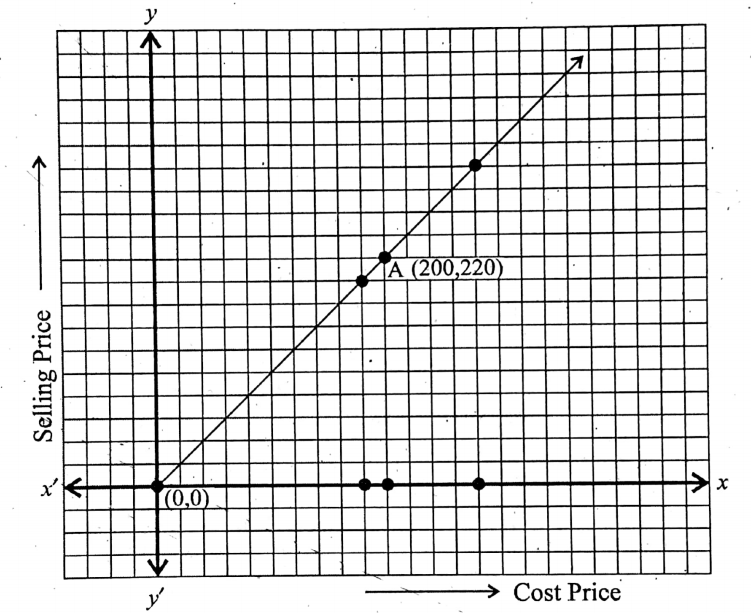
Now, let O be the origin (0, 0) and A denotes the point (200, 220). Let us draw a straight line joining O and A.
So, the graph obtained from the given information is a straight line.
From the graph, we see that:
1. Since the graph is a straight line, the C.P. of the book is directly proportional to the S.P. of it.
2. By reducing the production cost by 10%, we get, the new production cost
= ₹ (200 – 200 × 10%)
= \(₹\left(200-200 \times \frac{10}{100}\right)\)
= ₹ (200 – 20)
= ₹ 180
Again, the length of each side of the least squares of the graph paper = ₹ 20.
∴ ₹180 = \(\frac{180}{20}\) units
= 9 units.
So, moving 9 units right to the origin O along the x-axis and then moving upwards parallel to the y-axis we get a point on the straight line of the graph, which is at a distance of 10 units from the x-axis.
But, 10 units = ₹ 10×20
= ₹ 200.
∴ If the production cost is reduced by 10%, the S.P. 200.
3. According to the construction,
₹ 20 = 1 unit
∴ ₹1 = \(\frac{1}{20}\)
∴ ₹ 300= -units = 15units.
Now, the x-coordinate of the point on the straight line of the graph from which by moving 15 units parallel to the y-axis we get the x-axis, as 14, i.e., we have to move 14 units right to the origin O.
C.P. 14 units = ₹ 14 x 20 [∵ 1 unit = ₹ 20]
= ₹ 280
∴ The required C.P. = ₹ 280.
4. A discount of 10% on the M.P. is allowed for each book, i.e.,
if the M.P. be 100 then the S.P. = ₹ (100-10)
= ₹90.
Thus, when the S.P. is ₹ 90, the M.P. = ₹ 100
Thus, when the S.P. is ₹ 1, the M.P. = \(\frac{100}{90}\)
Thus, when the S.P. is ₹ 270, the M.P. = \(₹ \frac{100 \times 270}{90}\)
∴ The required M.P. = ₹ 300.
Thus, with the help of a graph, we can know much information related to profit and loss, such as C.P., S.P., percentage of Profit, Percentage of Loss, M.P., Discount, etc.
Some essential formulas :
1. If the percentage of Profit on C.P. be x%, then the percentage of profit on
S.P. = \(\frac{x}{100+x} \times 100 \%\) ………...(17)
2. If the percentage of profit on S.P. be x%, then the percentage of profit on.
C.P.= \(\frac{x}{100-x} \times 100 \%\) …………….(18)
3. If the percentage of loss on C.P. be y%, then the percentage of loss on
S.P. = \(\frac{x}{100-y} \times 100 \%\) …………..(19)
4. If the percentage of loss on S.P. be y%, then the percentage of loss on
C.P. = \(\frac{x}{100+y} \times 100 \%\) ………….(20)
5. If the C.P. of x particle is equal to the S.P. of y particle, then there will be
1. A profit of x > y and the percentage of profit = \(\frac{x-y}{y}\) ……….(21)
2. A loss of x <y and the percentage of loss = \(\frac{y-x}{y}\) ………..(22)
6. If the C.P. of an articular is a, then
1. At a profit of x%, the S.P. = \(\left(a+\frac{a x}{100}\right)\) ……………..(23)
2. At a loss of y%, the S.P. = \(\left(a-\frac{a x}{100}\right)\) …………….(24)
7. If the S.P. of an article is b, then
1. At a profit of x%, the C.P. = \(\frac{100 b}{100+x}\) ……………(25)
2. At a loss of y%, the C.P. = \(\frac{100 b}{100-x}\) ………….(26)
8. If the proportion of the C.P. and the S.P. of an article is a: b, then there will be
1. A profit if a <b and the percentage of profit = \(\frac{b-a}{a} \times 100 \%\) …….….(27)
2. A loss if a> b and the percentage of loss = \(\frac{a-b}{a} \times 100 \%\) ………….(28)
Note:
1. Percentage of profit on S.P. = \(\frac{b-a}{a} \times 100 \%\) ……….(29)
2. Percentage of loss on S.P. = \(\frac{a-b}{a} \times 100 \%\) …………(30)
9. An article gains so much when it is sold at ₹ b1 by as it losses when sold at b2 (b1> b2), then the C.P. of the article
S.P. = \(₹ \frac{b_1+b_2}{2}\)……………..(31)
10.
1. An article gains x,% when it is sold at b. The article will gain x2% when the
S.P.= \(\left(\frac{100+x_2}{100+x_1}\right)\) ………….(32)
2. An article gains x% when it is sold at b. The article will gain y% when the
S.P. = \(₹\left(\frac{100-y}{100+x}\right) \times b\) …………(33)
3. An article losses y% when it is sold at b. The article will gain x% when the
S.P. = \(₹\left(\frac{100+x}{100-y}\right) \times b\) ………….(34)
4. An article losses y1% when it is sold at b. The article will loss y2%, when the
S.P. = \(\left(\frac{100-y_2}{100-y_1}\right)\) ……………(35)
11.
1. An article was sold at a loss of y%. If the C.P. of the article had been less and the S.P. more than the previous, then there would have been a profit of x%.
∴ The C.P. of the article = \(=\frac{10(a+b)+a x}{x+y}\) ………..(36)
2. An article was sold at a profit of x%. If the C.P. of the article had been a more and the S.P. had been b less than the previous, then there would have been a loss of y%.
∴ The C.P. of the article = \(\frac{a y-100(a+b)}{x+y}\) …………(37)
12. The total C.P. of two articles is a. If one of them be sold at a profit of x% and the other at a loss of y%, then there would have been a profit of 2% (x > z) on the total C.P.
∴ The C.P. of one article = ₹ \(=\frac{a(y+z)}{x+y}\) and the C.P. of the other = \(=\frac{a(x-z)}{x+y}\) ………(38)
13. An article of a per kg is mixed with another article of b per kg and then the mixture is sold at a rate of c per kg so as to gain x% on the total C.P. Then the ratio of the mixture of the two articles is given by
= {bx – 100 (c – b)}:{100 (c – a) – ax} ………………………(39)
14. The M.P. of an article is fixed up b by raising its production cost a%. But during the selling of the article, a discount of x% is allowed on the M.P. Then
1. Percentage of Profit = \(\left\{a-x\left(1+\frac{a}{100}\right)\right\} \% \text { if } a>x\) ………..[40(1)]
2. Percentage of loss = \(\left\{x\left(1+\frac{a}{100}\right)-a\right\} \% \text { if } x>a\) …………….[40(2)]
15. The M.P. of an article is a. If three successive discounts of x%, y%, and 2% be allowed on the M.P., then
the S.P. of the article = a – a x (E.D.%), where E.D.%
=\(\left(x+y+z-\frac{x y+y z+z x}{100}+\frac{x y z}{10000}\right) \%=a-\frac{a}{100} \times \mathrm{E} . \mathrm{D} .\) (Equivalence discount)………………(41)
16.
1. The production cost of an article is ₹ a. The producer sells it to the wholesaler at ₹ b, the wholesaler sells it to the retailer at ₹ c and the retailer sells it to the customer at ₹ d. Then,
The percentage of profit of the producer = \(\frac{b-a}{a} \times 100 \%\) ……………[42(1)]
The percentage of profit of the wholesaler = \(\frac{c-b}{b} \times 100 \%\) ………….[42(2)]
The percentage of profit of the retailer = \(\frac{d-c}{c} \times 100 \%\) ……………… [42(3)]
2. A producer sells his product to the wholesaler at a profit of x%, the wholesaler sells it to the retailer at a profit of y% and the retailer sells it to the customer at a profit of z% for ……. ₹ a. Then, the production cost of the article……
= \(₹ \frac{1000000 a}{(100+x)(100+y)(100+z)}\) ……..[43(1)]
The C.P. of the wholesaler = \(₹ \frac{10000 a}{(100+y)(100+z)}\)………………..[43(2)]
The C.P. of the retailer = \(₹ \frac{100 a}{(100+z)}\) ………………..[43(3)]
17. If y articles are sold at b by buying x articles for a, then
1. there will be a profit if bx > ay and
the percentage of profit = \(\frac{b x-a y}{a y} \times 100 \%\) ……………………..[44(1)]
2. there will be a loss if bx < ay and
the percentage of loss = \(\frac{a y-b x}{a y} \times 100 \%\) ………………..[44(2)]
3. if a = b and x>y, then there will be a profit, and the percentage of profit
= \(\frac{x-y}{y} \times 100 \%\) ………………..[44(3)]
4. If a = b and x <y, then there will be a loss, and the percentage of loss
= \(\frac{y-x}{y} \times 100 \%\) ………….[44(4)]
18. An article is sold at the M.P. by buying it at a discount of x%, then
the percentage of profit = \(\frac{x}{100-x} \times 100 \%\)…………….(45)
Arithmetic Chapter 2 Profit And Loss Select the Correct Answer(MCQ)
1. If the C. P of an article is. 75% of its S. P., then the S. P. =
1. 133 \(\frac{1}{3}\)% of C.P.
2. 133 \(\frac{2}{3}\)
3. 25% C.P.
4. 125% of C.P.
Solution:
Let the S.P. of an article is x
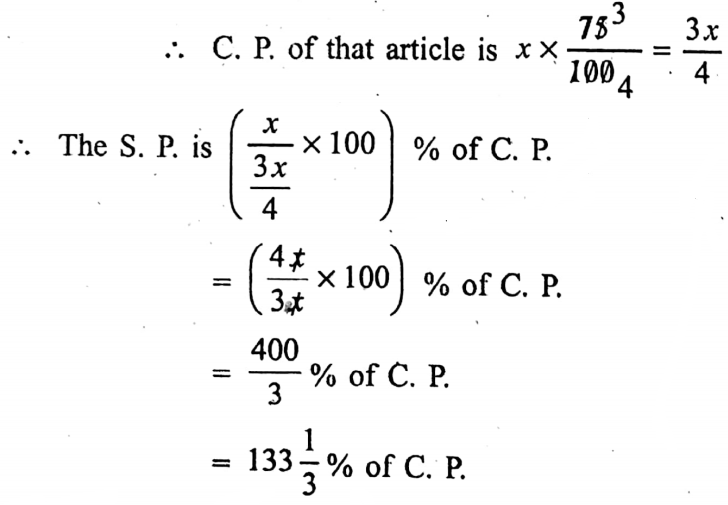
∴ The correct answer is 1. 133 \(\frac{1}{3}\)% of C.P.
2. If the ratio of the S. P. of an article to its M. P. be 4: 5, then the discount allowed =
1. 1
2. 1
3. 20%
4. 25%
Solution:
Let S. P. of an article be ₹ 4x and M. P. be ₹ 5x [ x is common multiple and x > 0]
Discount is (₹ 5x – ₹ 4x) = x
∴ Discount = \(\left(\frac{₹ x}{₹ 5 x} \times 100\right) \%\)
= 20%
∴ The correct answer is 3. 20%
3. The C. P. of an article is a. The M. P. of the article is b and the discount is x%. Which one of the following conditions is correct so that these will be a profit on selling the article?
1. x < 100 \(\)
2. x >100 \(\)
3. x < 100 \(\)
4. x > 100 \(\)
Solution: M. P. of an article is b and the discount is x%.
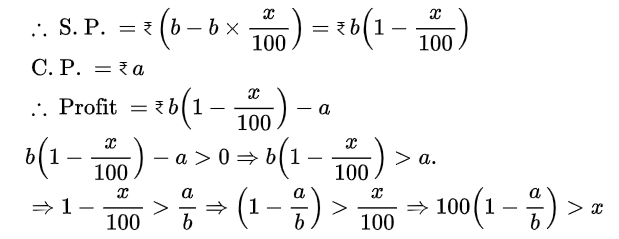
∴ The correct answer is 1. x < 100 \(\)
Arithmetic Chapter 2 Profit And Loss Short Answer Type Questions
Examples 1. Rambabu buys 10 apples for 30 and sells them at a rate of 42 per dozen. Find the percentage of profit or loss.
Solution:
1. By arithmetic rule:
Rambabu buys 10 apples for ₹ 30.
Rambabu buys 10 apples for ₹ \(\frac{30}{10}\)
Rambabu buys 10 apples for \(₹ \frac{30 \times 12}{10}=₹ 36\)
Rambabu sells 12 apples at ₹ 42.
∴ Total profit (₹ 42 – ₹ 36) =
∴ The percentage of profit = \(\frac{6}{36} \times 100 \%\)
= \(16 \frac{2}{3} \%\)
The percentage of profit = \(16 \frac{2}{3} \%\)
2. By competitive exam rule (Short-cut rule) :
Percentage of profit = \(\frac{42 \times 10-30 \times 12}{30 \times 12} \times 100 \%\)
= \(\frac{420-360}{360} \times 100 \%\)
= \(\frac{100}{6} \%\)
= \(16 \frac{2}{3} \%\)
[By formula 44. (1), here a= 30, b = 42, x = 10, y = 12.]
Example 2. Badalbabu sold an article at a loss of 20%. Had the S.P. of the article been 200 more, there would have been a profit of 5%. What was the S.P. of the article?
Solution:
1. By arithmetic rule:
If the C.P. be 100, then at a loss of 20%, the S.P. (100-20) 80, and at a profit of 5%, S.P. (100+5)=
105.
∴ The S.P. becomes ₹(105 – 80) = 25 more than the previous.
Now,
if the S.P. is ₹ 25 more, the C.P. = ₹ 100
if the S.P. is ₹1 more, the C.P. = ₹\(\frac{100}{25}\)
if the S.P. is ₹200 more, the C.P. = \(₹ \frac{100 \times 200}{25}\)
∴ The required C.P. = ₹ 800.
2. By algebraic rule:
Let the C.P. = ₹ x.
∴ At a loss of 20%, the S.P. = \(\left(x-x \times \frac{20}{100}\right)\)
= \(\frac{4x}{5}\)
and at a profit of 5%, the S.P. = \(₹\left(x+x \times \frac{5}{100}\right)=₹ \frac{21 x}{20}\)
As per question, \(\frac{21x}{20}\) – \(\frac{4x}{5}\)
= 200
or,\(\frac{21 x-16 x}{20}=200\)
or, \(\frac{5x}{20}\)
or,x = 800
∴ The required C.P = ₹ 800
3. By Competitive exam. rule (Short-cut rule):
The C.P. of the article = \(₹ \frac{100(0+200)+0 \times 5}{5+20}\)
= ₹ 800
The C.P. of the article = ₹ 800
Example 3. Supriya by selling her chair at 370 gains so much as she losses by selling it at 210. What was the C.P. of the chair?
Solution:
1. By arithmetic rule:
Profit 370 – C.P. and Loss C.P. – ₹ 210.
As per the question, ₹ 370 – C.P. = C.P. – ₹210.
or, C.P. + C.P = ₹ 370 + ₹ 210
or, 2 x C.P. = ₹ 580
or, C.P. = ₹ \(\frac{580}{2}\)
= ₹ 290,
∴ The required. C.P. = ₹290.
2. By algebraic rule:
Let C.P. = ₹ x,
∴ Profit = ₹ (370 – x)
and Loss = ₹ (x-210)
As per the question, 370 – x = x – 210.
or, x + x = 370 + 210
or, 2x = 580
or, x \(\frac{580}{2}\)
= 290.
∴ The required C.P. = ₹ 290.
3. By competitive exam. rule (Short-cut rule) :
The required C.P. = \(₹ \frac{370+210}{2}\)
= ₹ \(\frac{580}{2}\)
=290.
[By formula (31), here b1 = 370, b2 = 210.]
Example 4. Laxmanbabu bought a book from the market with a discount of 25%. If it had been sold by him to Arunbabu at the price of M.P., then what would have been the percentage of profit?
Solution:
1. By arithmetic rule:
At a discount of 25%, if the M.P. of the book is ₹ 100, then the S.P. of the book ₹ (100-25) = ₹ 75.
∴ The C.P. of Laxmanbabu ₹ 75
The S.P. of the book ₹ 100, when it is sold at M.P.
∴ The percentage of profit = \(\frac{100-75}{75} \times 100 \%\)
= \(33 \frac{1}{3} \%\)
2. By algebraic rule:
Let the M.P. be ₹ x.
At a discount of 25%, the C.P. of Laxmanbabu = \(₹\left(x-x \times \frac{25}{100}\right)=₹ \frac{3 x}{4}\)
The S.P. of the book = ₹ x, when it is sold at M.P.
The percentage of profit = \(\frac{x-\frac{3 x}{4}}{\frac{3 x}{4}} \times 100 \%\)
= \(\frac{\frac{x}{4}}{\frac{3 x}{4}} \times 100 \%\)
= \(=33 \frac{1}{3} \%\)
3. By competitive exam. rule (Short-cut rule) :
The required percentage of profit = \(\frac{25}{100-25} \times 100 \%\)
= \(\frac{25}{75} \times 100 \%\)
= \(\frac{1}{3} \times 100 \%\)
= \(\frac{100}{3} \%\)
= \(33 \frac{1}{3} \%\)
Arithmetic Chapter 2 Profit And Loss Long answer type Questions
Example 1. Anis’s uncle sold his umbrella at a profit of 5%. Had it been sold for 34 less and the C.P. of the umbrella had been 20% less than the previous, there would have been a profit of 10%. What was the C.P. of the umbrella?
Solution:
1. By arithmetic rule :
At a profit of 5%, if the C.P. of the umbrella is ₹ 100, then its S.P. = ₹ (100 + 5)
= ₹ 105.
At a reduction of 20%, the C.P. of the umbrella = ₹(100 – 20)
= ₹ 80.
Then, at a profit of 10%, the S.P. = \(₹\left(80+80 \times \frac{10}{100}\right)\)
∴ The S.P. becomes = ₹ (105 – 88)
= ₹ 17 less than the previous.
∴ The S.P. becomes ₹ 17 less when the C.P. of the umbrella = ₹ 100
The S.P. becomes ₹1 less when the C.P. of the umbrella = ₹ \(\frac{100}{17}\)
the S.P. becomes ₹ 34 less when the C.P. of the umbrella = \(₹ \frac{100 \times 34}{17}\)
∴ The required C.P. = ₹ 200.
2. By Algebraic rule:
Let the C.P. of the umbrella be ₹ x.
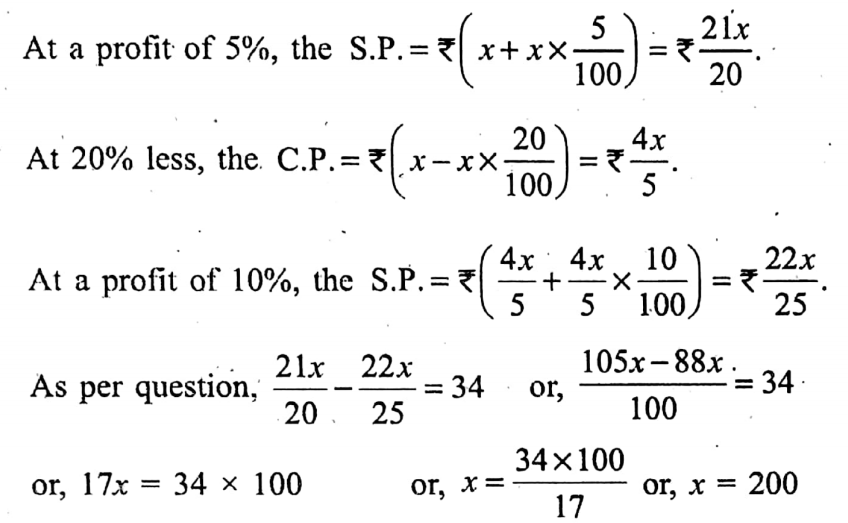
∴ the required C.P. = ₹ 200.
3. By competitive exam. rule (Short – cut rule):
The required C.P.
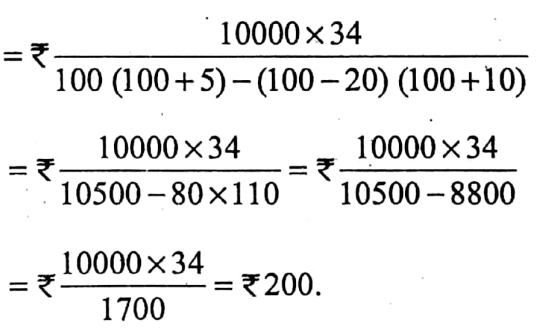
Example 2. By selling 12 articles per rupee, there is a loss of 4%. How many articles should be sold per rupee so as to gain 44% ?
Solution:
1. By arithmetic rule :
At a loss of 4%, the C.P. of 12 articles = \(₹ \frac{100}{100-4}\)
= ₹ \(\frac{100}{96}\)
= ₹ \(\frac{25}{44}\)
At a profit of 44% the S.P. of 12 articles = \(₹\left(\frac{25}{24}+\frac{25}{24} \times \frac{44}{100}\right)\)
= \(₹ \frac{25}{24}\left(1+\frac{11}{25}\right)\)
= ₹ \(\frac{36}{24}\)
= ₹ \(\frac{3}{2}\)
∴ For ₹ \(\frac{3}{2}\), the number of articles to be sold = 12.
For ₹ 1 the number of articles to be sold = \(\frac{12}{\frac{3}{2}}\)
= \(\frac{12 \times 2}{3}\)
= 8
∴ the required number of articles = is 8.
2. By algebraic rule:
Let x article should be sold at ₹ 1.
Now, at a profit of 44%, if the S.P. be (100+44), the C.P. = ₹ 100
∴ If the S.P. be ₹ 1, the C.P. = \(₹ \frac{100}{100+44}\)
= \(\frac{25}{36}\)
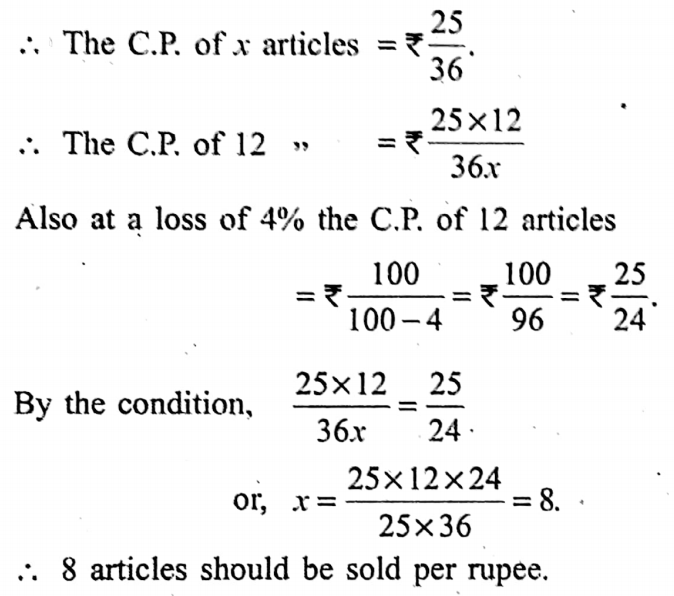
Example 3. The mother of Prosanto’s uncle producing two sarees sold one of them, at a profit of 15% and the other at a profit of 20%. Thus, she had a total profit of ₹ 262.50. If the ratio of the production costs of two sarees is 1: 3, then find the production cost of each.
Solution:
1. By arithmetic rule:
The ratio of the production costs of two sarees is given by 1: 3.
∴ If we let, the production of one of the sarees be ₹ 100, then that of the other = ₹ 3 × 100
= ₹ 300.
At a profit of 15%, the profit generated by the first saree = ₹ 15.
At a profit of 20%, the profit generated by the second saree = \(₹ \frac{20 \times 300}{100}\)
= ₹ 60
∴ The total profit = ₹ (15+60)
= ₹ 75.
When the total profit is ₹ 75, the production cost of the first is ₹ 100
When the total profit is ₹ 1, the production cost of the first is ₹ \(\frac{100}{75}\)
When the total profit is ₹ 262.50 the production cost of the first is ₹ \( \frac{100 \times 262 \cdot 50}{75}\)
= ₹ 350.
∴ The production cost of the second = ₹ 350 x 3
= ₹ 1050.
∴ The required production costs are ₹ 350 and ₹ 1050 respectively.
2. By algebraic rule:
Let the production cost be ₹ x and ₹ 3x [ ∵ the ratio = 1: 3]
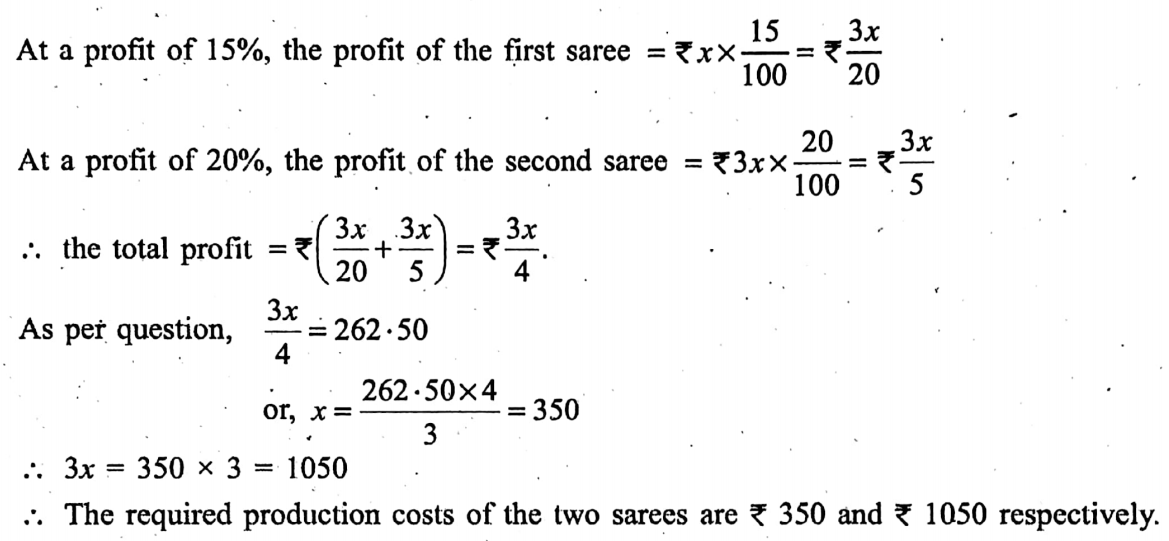
3. By competitive exam, rule (Short cut rule):

Example 4. Biswakarma Sutradhar produced two cots and fixed the M.P. of each cot ₹ 1250. He gained a profit of 15% by selling one of cots with a discount of 8%. If he sold the second cot at ₹ 1120, then find the percentage of profit earned by him.
Solution:
1. By arithmetic rule:
At a discount of 8%, if the M.P. be 1250, then the S.P. = \(\left(₹ 1250-1250 \times \frac{8}{100}\right)\)
= ₹1150.
Again, at a profit of 15%, if the S.P. be ₹ 1150,
The production cost = \(₹ \frac{100 \times 1150}{100+15}\)
∴ The production cost of each cot = ₹ 1000.
∴ The production costs of two cots ₹ 1000 x 2 = ₹ 2000
The S.P. of two cots ₹ (1150+1120) = ₹ 2270.
∴ The total profit = ₹ (2270-2000) = 270.
The percentage of profit = \(\frac{270}{2000} \times 100 \%\)
= \(13 \frac{1}{2} \%\)
2. By algebraic rule:
Let the percentage of profit be x%.
Now, at a discount of 8%, if the M.P. be ₹ 1250, then the
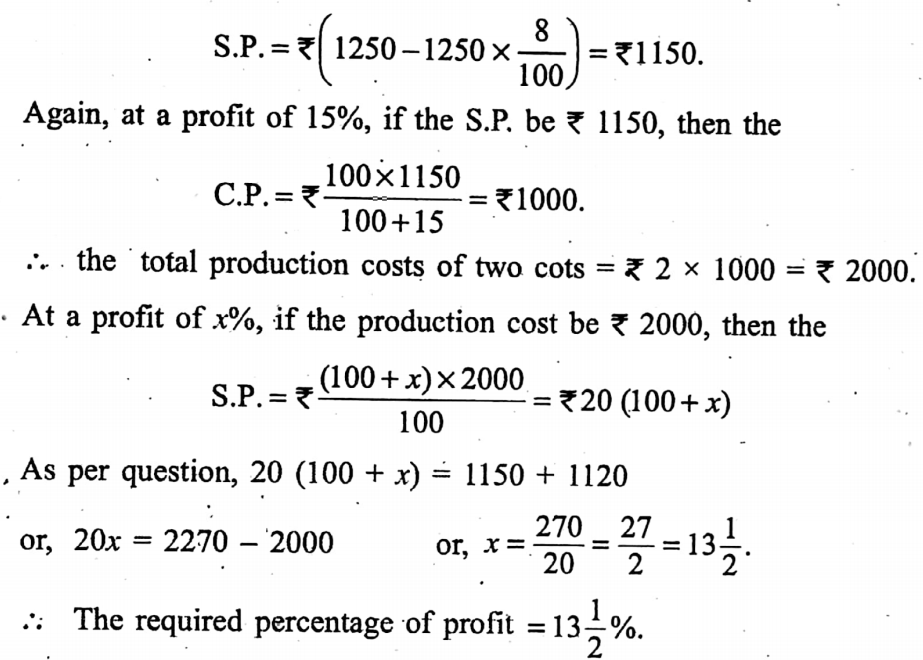
3. By competitive exam. rule (shortcut rule):
The required percentage of profit
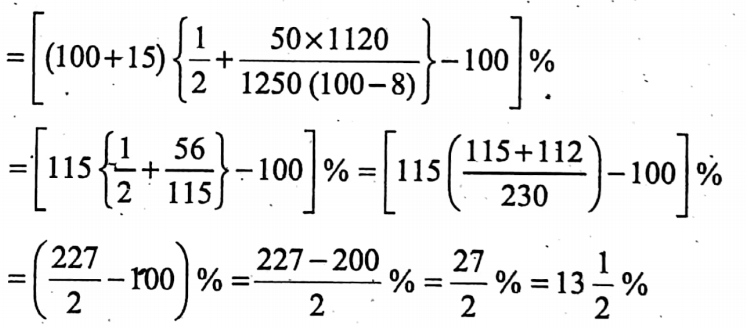
Example 5. Suvradevi bought some lozenges at a rate of 15 per 2 rupees. She sold half of the lozenges at a rate of 5 per rupee and the rest at a rate of 10 per rupee. Find the percentage of her profit or loss.
Solution:
1. By arithmetic rule:
Suvradevi buys 15 lozenges for rupees 2.
∴ She buys 100 rupees \(\frac{15}{2} \times 100\) lozenges = 750 lozenges.
Now, half of 750 lozenges = \(\frac{750}{2}\) lozenges 375 lozenges
She sells 5 lozenges at ₹ 1
∴ She sells 1 lozenges at \(₹ \frac{1}{5} \times 375\)
= ₹ 75
Also, she sells 10 lozenges at ₹ 1.
∴ Also, she sells 10 lozenges at \(₹ \frac{1}{10} \times 375\)
= ₹ \(\frac{75}{2}\)
∴ The total S.P. = \(₹\left(75+\frac{75}{2}\right)\)
\(\frac{225}{2}\)
∴ Total profit = \(₹\left(\frac{225}{2}-100\right)\)
\(\frac{25}{2}\)
∴ Percentage of profit = \(\frac{25}{2} \%\)
= \(12 \frac{1}{2} \%\) [ C.P. = ₹ 100]
2. By algebraic rule:
Let Suvradevi buy x lozenges.
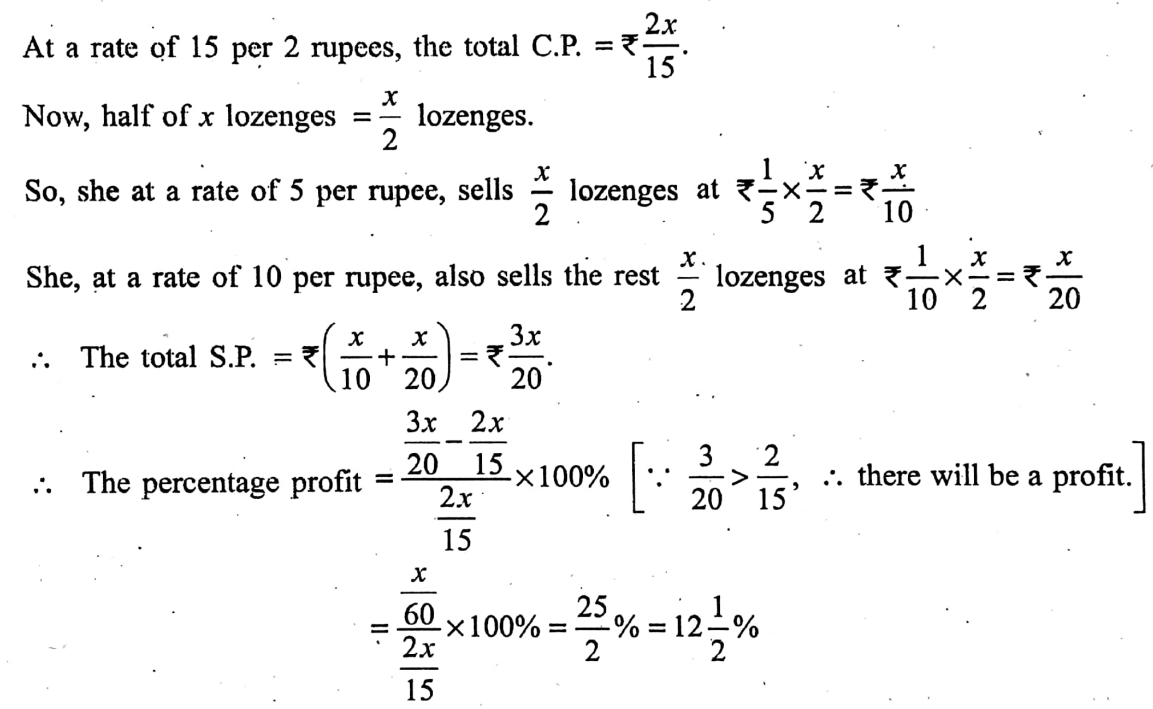
3. By competitive exam. rule (Short-cut rule):
The required percentage of profit = \(\left\{\frac{15}{2}\left(\frac{5+10}{2 \times 5 \times 10}\right)-1\right\} \times 100 \%\)
= \(=\left(\frac{15}{2} \times \frac{15}{100}-1\right) \times 100 \%\)
= \(\frac{25}{200} \times 100 \%\)
= \(\frac{25}{2} \%\)
= \(12 \frac{1}{2} \%\)
Example 6. To publish 2000 copies of a book, Calcutta Book House expensed a total of 8000. The company sold the books to the book-sellers at a profit of 20% allowing them a discount of 20%. What was the M.P. of each book?
Solution:
1. By arithmetic rule:
The production cost of each book = \(\frac{8000}{2000}\)
= ₹ 4.
At a profit of 20%, the S.P. of each book = \(\frac{100+20}{100} \times 4\)
= ₹ \(\frac{24}{5}\)
At a discount of 20%, the M.P. of each book = \(₹ \frac{100}{100-20} \times \frac{24}{5}\)
= \(₹ \frac{100 \times 24}{80 \times 5}\)
= ₹ 6.
The M.P. of each book = ₹ 6.
2. By algebraic rule:
Let the M.P. of each book be ₹ x.
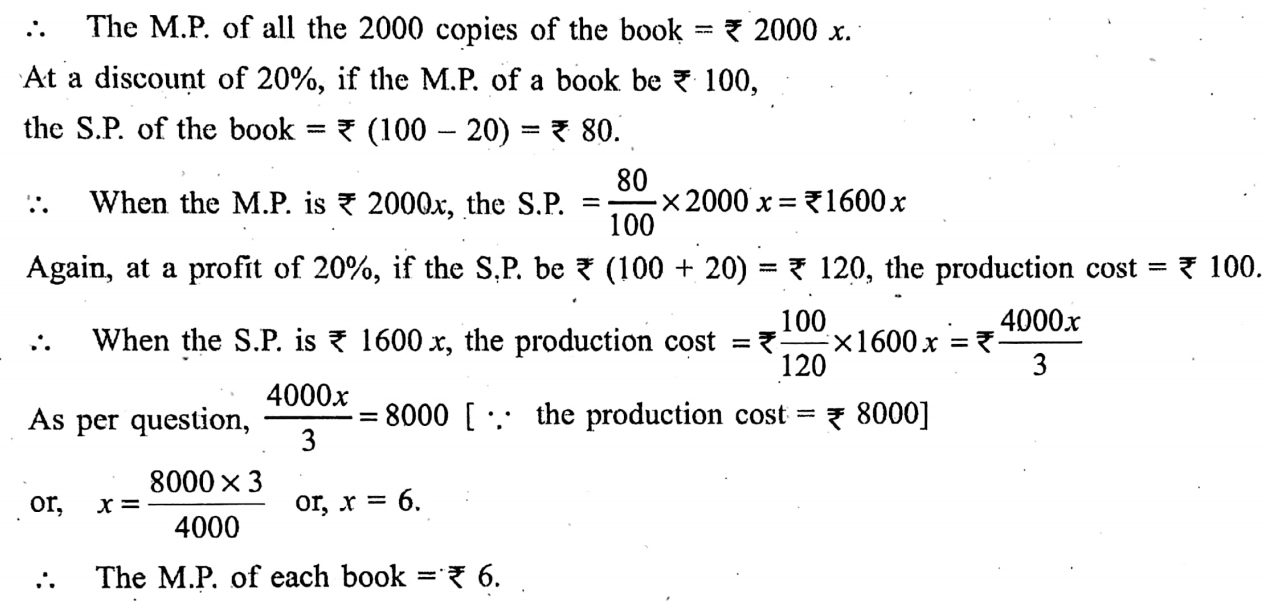
3. By compititive exam. rule (Shortcut rule):
The M.P. of each book = ₹ \(=\frac{8000}{2000}\left(\frac{100+20}{100-20}\right)\)
= \(₹ 4 \times \frac{120}{80}\)
= ₹ 6.
Example 7. A person bought some mangoes at a rate of 15 per rupee. He also bought the same number of mangoes at a rate of 12 per rupee. By mixing the mangoes, he sold all the mangoes at a rate of 13 per rupee. Find his percentage of profit or loss.
Solution:
1. By arithmetic rule:
The person bought 15 mangoes for 1 rupee.
The person bought 1 mango for \(\frac{1}{15}\) rupee
Again, the person bought 12 mangoes for 1 rupee.
Again, the person bought 1 mango for \(\frac{1}{12}\) rupee.
∴ He bought (1+1)= 2 mangoes for \(₹\left(\frac{1}{15}+\frac{1}{12}\right)\)
= ₹ \(\frac{3}{20}\)
∴ He bought 1 mango \(₹ \frac{3}{20 \times 2}\)
= ₹ \(\frac{3}{40}\)
Again, he sold 13 mangoes (after mixing) at ₹ 1.
Again, he sold 1 mango (after mixing) at ₹ \(\frac{1}{13}\)
∴ Profit = \(₹\left(\frac{1}{13}-\frac{3}{40}\right)\) \(\frac{1}{13}\) > \(\frac{3}{40}\)
= ₹ \(\frac{40-39}{520}\)
∴ The percentage of profit = \(\frac{\frac{1}{520}}{\frac{3}{40}} \times 100 \%\)
= \(\frac{1}{520} \times \frac{40}{3} \times 100 \%\)
= \(2 \frac{22}{39} \%\)
2. By algebraic rule:
Let the person buy x mangoes at the first lot.
So, he also bought x mangoes at the second lot.
Now, the person bought 15 mangoes for 1
Now, the person bought x mangoes for \(₹ \frac{1}{15} \times x\)
= ₹ \(\frac{x}{15}\)
Again, he bought 12 mangoes for ₹ 1.
Again, he bought x mangoes for \(₹ \frac{1}{12} \times x\)
= ₹ \(\frac{x}{12}\)
.. He bought (x + x) = 2x mangoes for\(₹\left(\frac{x}{15}+\frac{x}{12}\right)\)
= ₹ \(\frac{3x}{20}\)
The person sold 13 mangoes (after mixing) at 1.
The person sold 2x mangoes at \(₹ \frac{1}{13} \times 2 x\)
= ₹ \(frac{2x}{13}\)
The percentage of profit = \(\frac{\frac{2 x}{13}-\frac{3 x}{20}}{\frac{3 x}{20}} \times 100 \%\)
= \(\frac{x}{260} \times \frac{20}{3 x} \times 100 \%\)
= \(\frac{100}{39} \%\)
= \(2 \frac{22}{39} \%\)
3. By competitive exam rule (Short-cut rule):
The required percentage of profit = \(\frac{2 \times 15 \times 12-15 \times 13-12 \times 13}{13(15+12)} \times 100 \%\)
= \(\frac{360-195-156}{13 \times 27} \times 100 \%\)
= \(\frac{9}{13 \times 27} \times 100 \%\)
= \(\frac{100}{39} \%\)
= \(2 \frac{22}{39} \%\)
Example 8. A person sold two houses each for ₹ 39100. He made a profit of 15% on the first house and a loss of 10% on the second. What was his net profit or loss?
Solution:
1. By arithmetic rule:
At a profit of 15% if the S.P. be ₹ (100 + 15) = ₹ 115, the profit = ₹15
if the S.P. be ₹ 1 = ₹ 115, the profit = ₹ \(\frac{15}{115}\)
if the S.P. be ₹ 39100 = ₹ 115, the profit = ₹ \(\frac{15 \times 39100}{115}\)
= ₹ 5100.
At a profit of 15% if the S.P. be ₹ (100 – 10) = ₹ 90, the loss = ₹10.
if the S.P. be ₹ 1 = ₹ 90, the loss = ₹\(/frac{10}{90}\)
if the S.P. be ₹ 39100 = ₹ 90, the loss = ₹ \(\frac{10 \times 39100}{90}\)
= ₹ \(\frac{39100}{9}\)
∴ His net profit = \(₹\left(5100-\frac{39100}{9}\right)\)
= \(₹ \frac{45900-39100}{9}\)
= ₹ \(\frac{6800}{9}\)
= \(₹ 755 \frac{5}{9}\)
2. By algebraic rule:
Let the C.P. of the first house be = ₹ x.
∴ The profit on the first house = ₹ \(x \times \frac{15}{100}\)
= ₹\(\frac{3x}{20}\)
As per question, \(x+\frac{3 x}{20}\) =39100
or, \(\frac{23x}{20}\) = 39100
or, x = \(\frac{39100 \times 20}{23}\)
= 5100.
∴ The profits on the first house = ₹ 5100.
Again, let the C.P. of the second house be ₹ y.
∴ The loss on the second house = ₹ \(y \times \frac{10}{100}\)
= ₹ \(\frac{y}{10}\)
As per question, \(y-\frac{y}{10}\) = 39100
or, \(\frac{9y}{10}\)= 39100
Or, \(\frac{y}{10}\) = \(\frac{39100}{9}\)
∴ The loss on the second house = ₹ \(\frac{39100}{9}\)
∴ His net profit = ₹ \(\left(5100-\frac{39100}{9}\right)\)
= ₹ \(755 \frac{5}{9}\)
3. By competitive exam. rule (Short-cut rule):
The required net profit
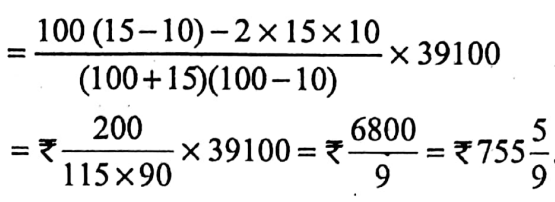
Formula: Two articles are sold each for ₹ a. There was a profit of x% on the first article and a loss of y% on the second article, then
1. Net Profit = \(₹ \frac{100(x-y)-2 x y}{(100+x)(100-y)} \times a\) , when this expression is positive.
2. Net Loss = \(₹ \frac{100(y-x)+2 x y}{(100+x)(100-y)} \times a\) , when this expression is negative.
Example 9. The M.P. of a bicycle is 4000. While selling the bicycle if three successive discounts of 20%, 10%, and 5% are allowed, then what price will the customer pay for it?
Solution:
1. By arithmetic rule:

2. By algebraic rule:
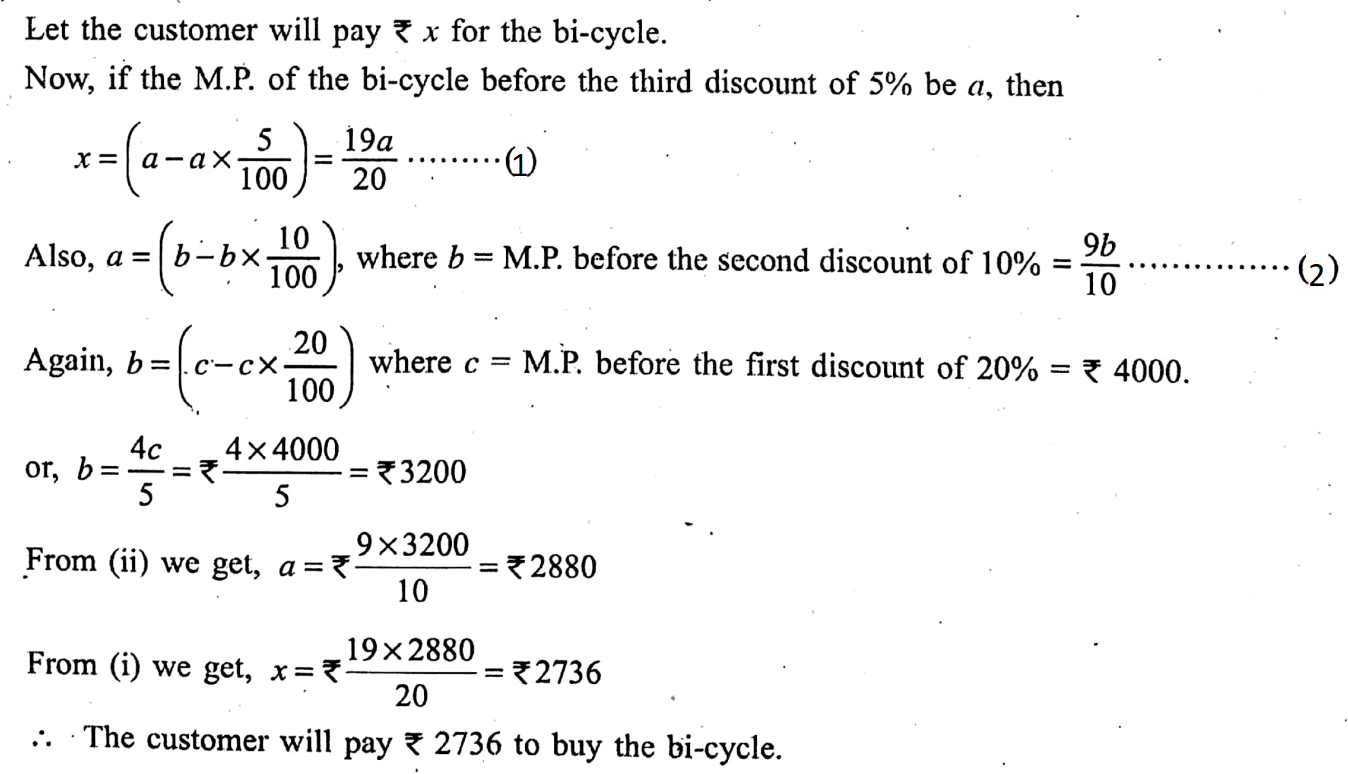
3. By competitive exam rule(Shortcut rule):
The required C.P.
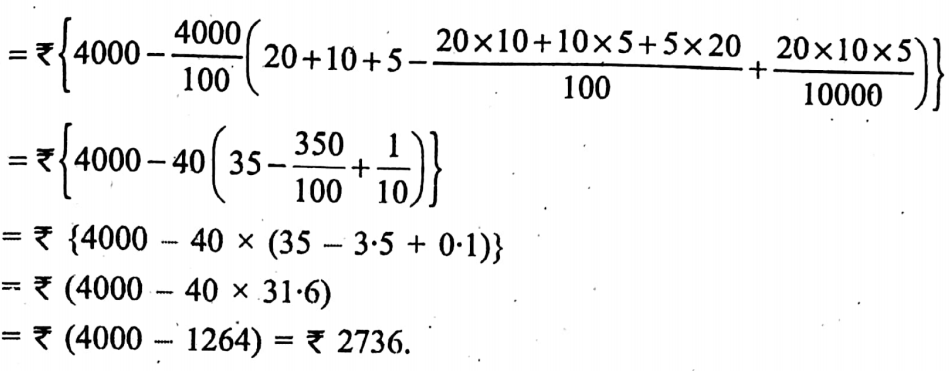
Example 10. Onkernath sold a saree at a profit of 20% and a shirt at a profit of 15% and got a total S.P. of ₹ 719.50. Had the saree been sold at a profit of 25% and the shirt at a profit of 20%, then there would have been a total S.P. of ₹ 30.50 more. Find the C.P. of the saree and the shirt.
Solution:
1. By arithmetic rule:
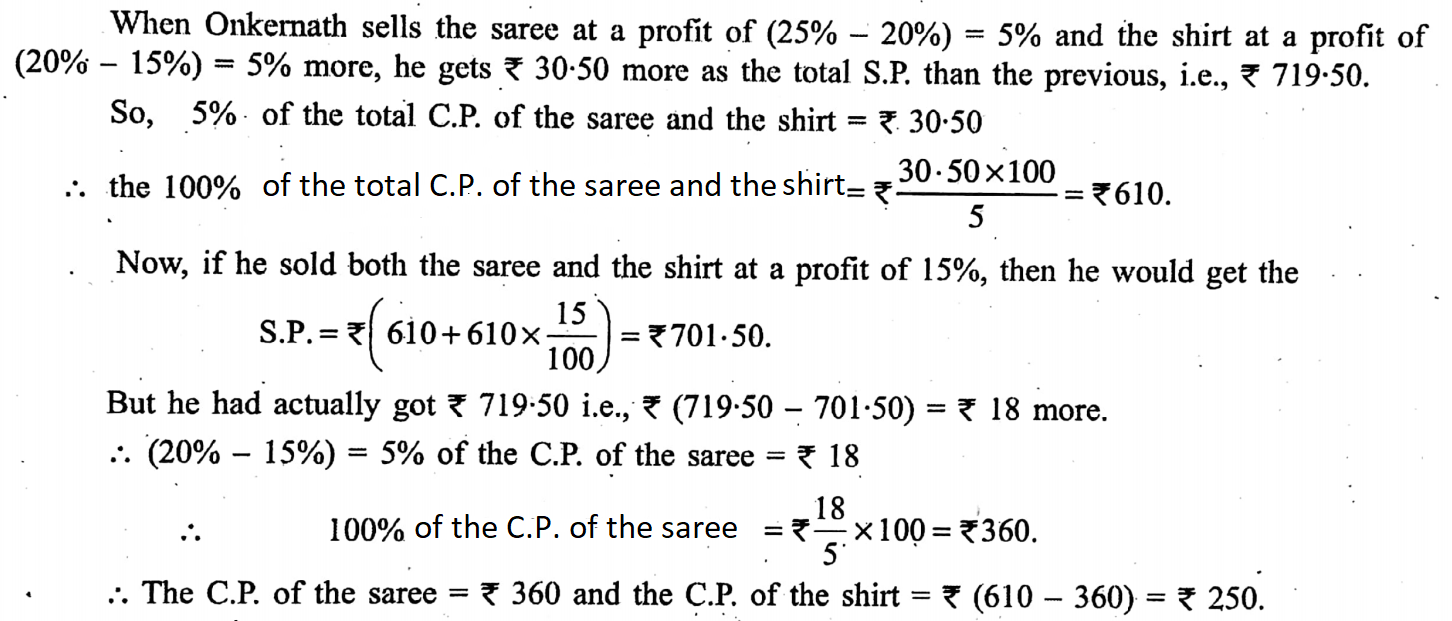
2. By algebraic rule:
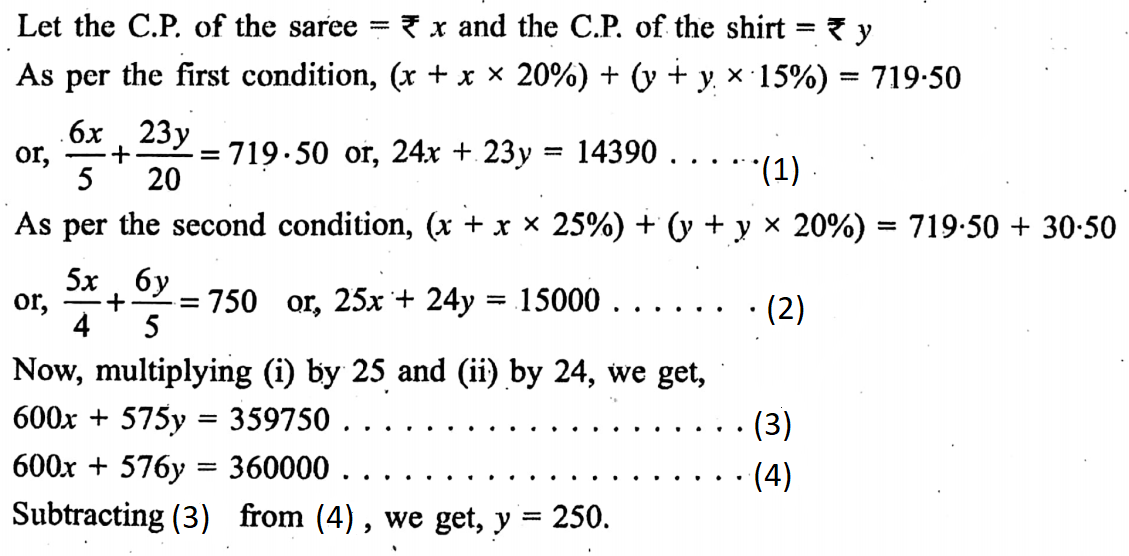
Again, from (2), we get, 25 x = 15000 – 24 x 250.
or, 25x = 15000 – 6000
or, x = \(\frac{9000}{25}\)
or, x = 360.
∴ The C.P. of the saree = ₹ 360 and the C.P. of the shirt = ₹ 250.
3. By competitive exam rule (Short-cut rule):
The C.P. of the shirt
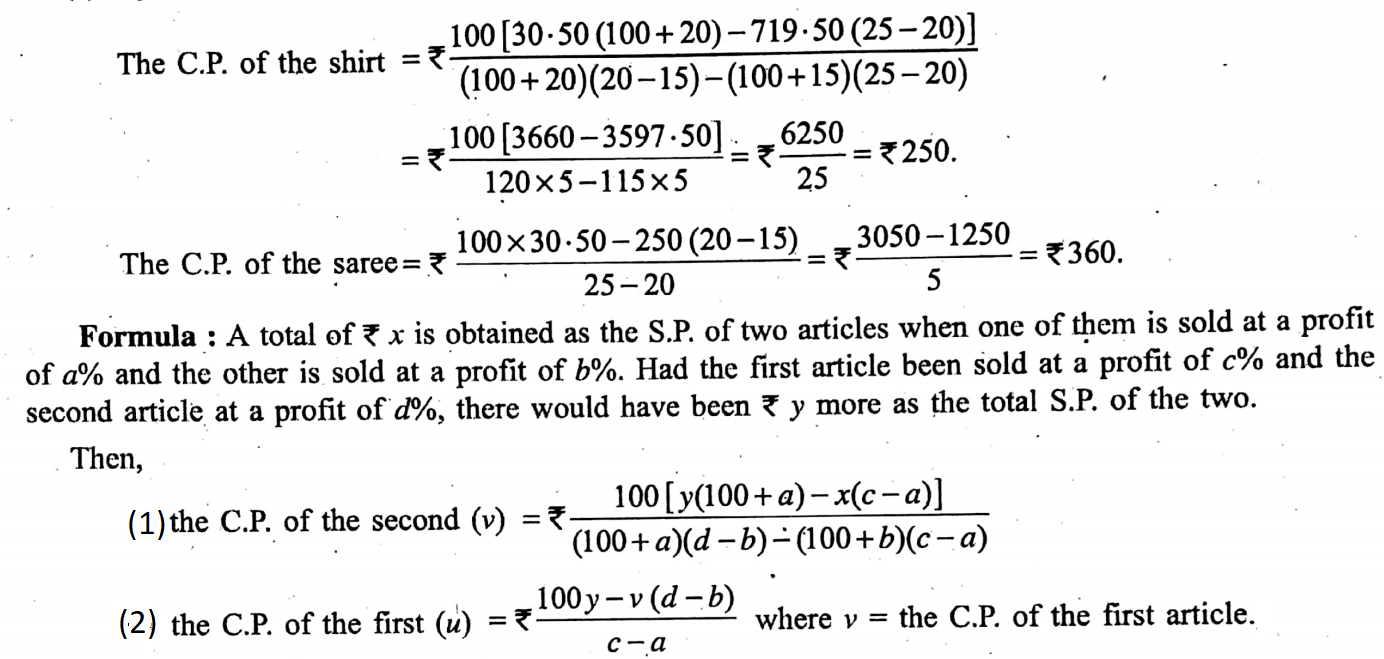
Example 11. Rambabu bought oil for 36000. He sold ⅓ rd of the oil at a loss of 20% and 2/5th of the oil at a profit of 25%. At what percentage of profit the rest of the oil should he sell so as to earn a profit of 10% as a whole?
Solution:
1. By arithmetic rule :
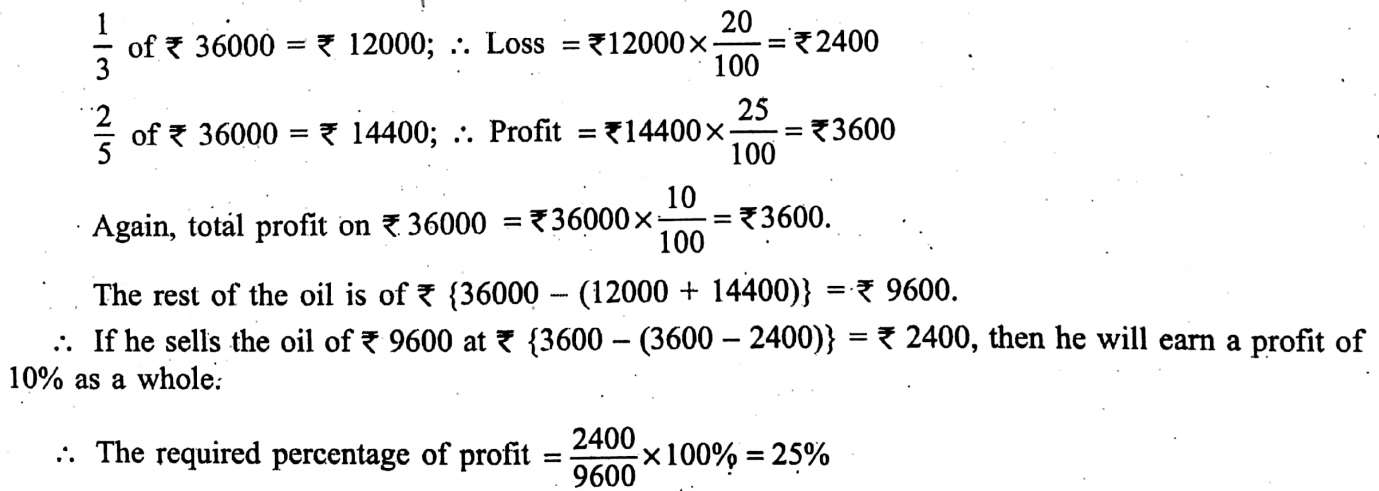
2. By algebraic rule:
Let the rest of the oil will have to sell at a profit of x%.
Now, the rest part of the oil = \(\left\{1-\left(\frac{1}{3}+\frac{2}{5}\right)\right\}\) part
= \(/frac{4}{15}\)
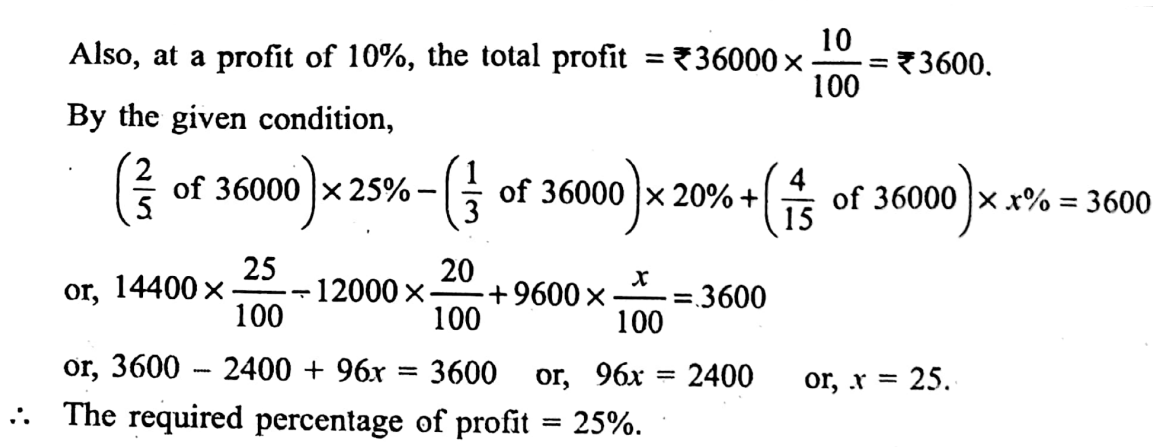
3. By competitive exam rule (Short-cut rule):
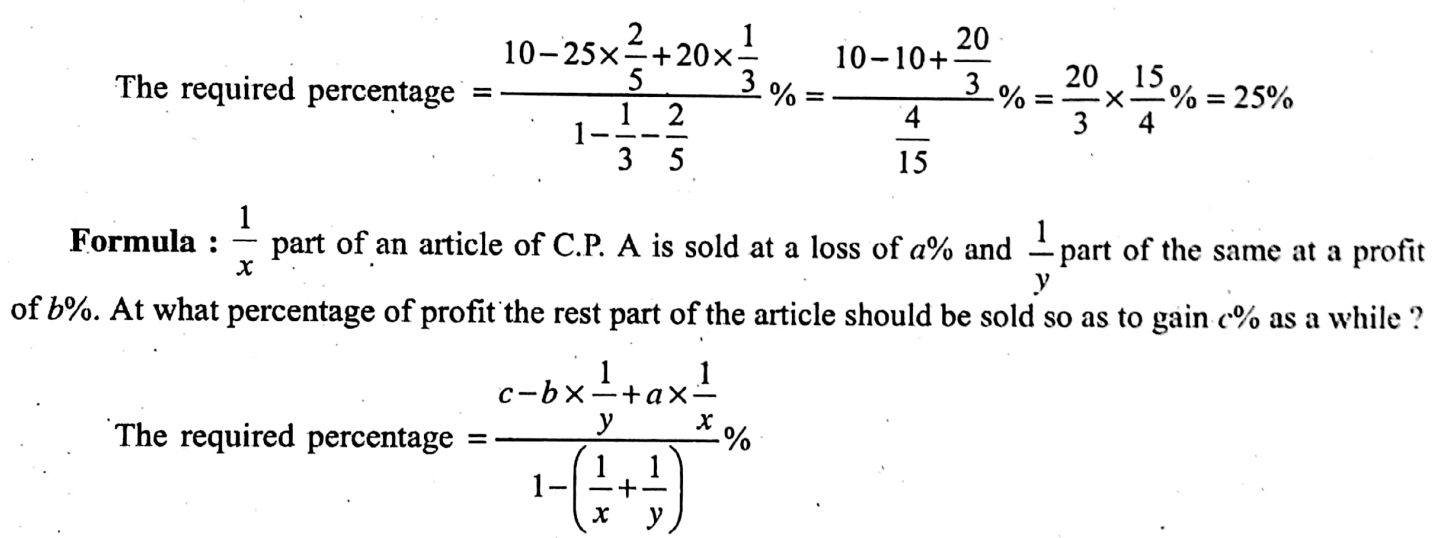
Example 12. Swapan Mudi sells two kinds of tea. One at a rate of 80 per kg resulting in a loss of 20% and the other at a rate of 200 per kg resulting in a profit of 25%. At what proportion should he mix these two kinds of tea so as to gain 25% by selling it at a rate of 150 per kg?
Solution:
1. By arithmetic rule:

2. By algebraic rule:
Let x kg of the first kind of tea be mixed with y kg of the second kind of tea.
Now, the C.P. of the first kind = \(₹ \frac{100}{100-20} \times 80\) per kg.
= ₹100 per kg.
The C.P of the second kind = \(₹ \frac{100}{100+25} \times 80\) per kg.
=₹160 per kg.
The C.P. of the mixed tea \(₹ \frac{100}{100+25} \times 150\) per kg.
= ₹120 per kg.
As per the condition, 100x + 120 (x + y) [∵ Total mixed tea = (x + y) kg]
or, 100x + 160y = 120x + 120y
or, 120x – 100x = 160y 120y
or, 20x = 40y
or, \(\frac{x}{y}\) = \(\frac{40}{20}\)
= \(\frac{2}{1}\)
∴ Hence, the required proportion is 2: 1.
3. By competitive exam. rule (Short-cut rule):
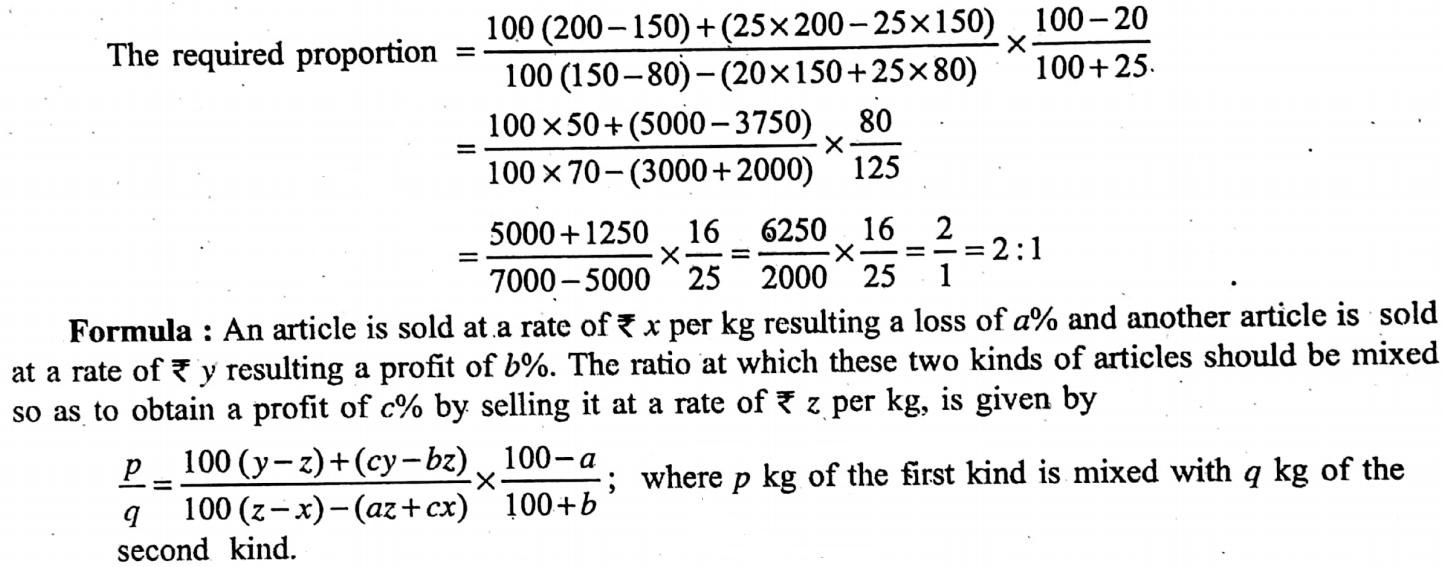
Example 13. While preparing a mixture of tea, 2% of tea is lost. In what ratio should a trader mix two kinds of tea costing 60 per kg and 45 per kg respectively so that he may gain 25% on selling the mixed tea at 62.50 per kg?
Solution:
1. By arithmetic rule:
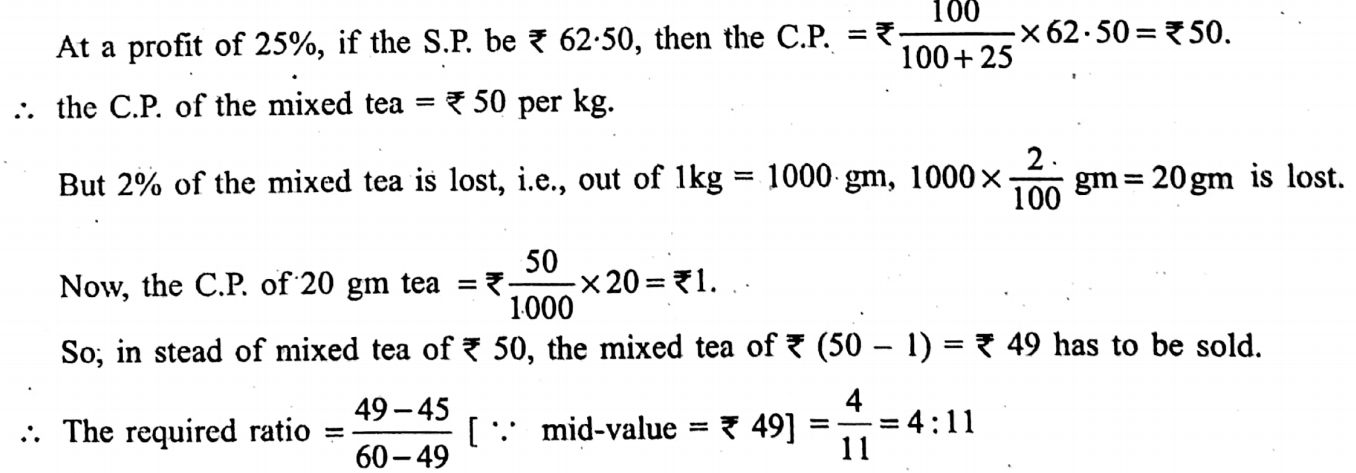
2. By algebraic rule:
Let x kg of the first kind of tea be mixed with y kg of the second kind of tea.
The total mixed tea = (x + y) kg.
But 2% of the mixed tea is lost.
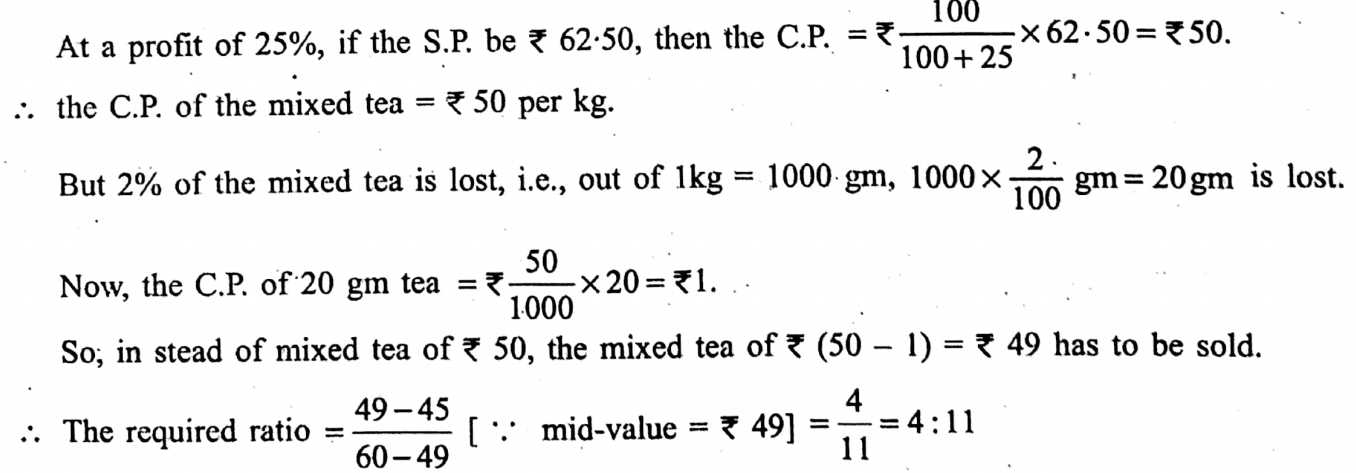
3. By competitive exam rule (Short cut rule):

Example 14. A sold a watch to B at a loss of 10%, and B sold it to C at a profit of 10%. If A had sold the watch for the price C paid, how much percent would A have gained or lost?
Solution:
1. By arithmetic rule :
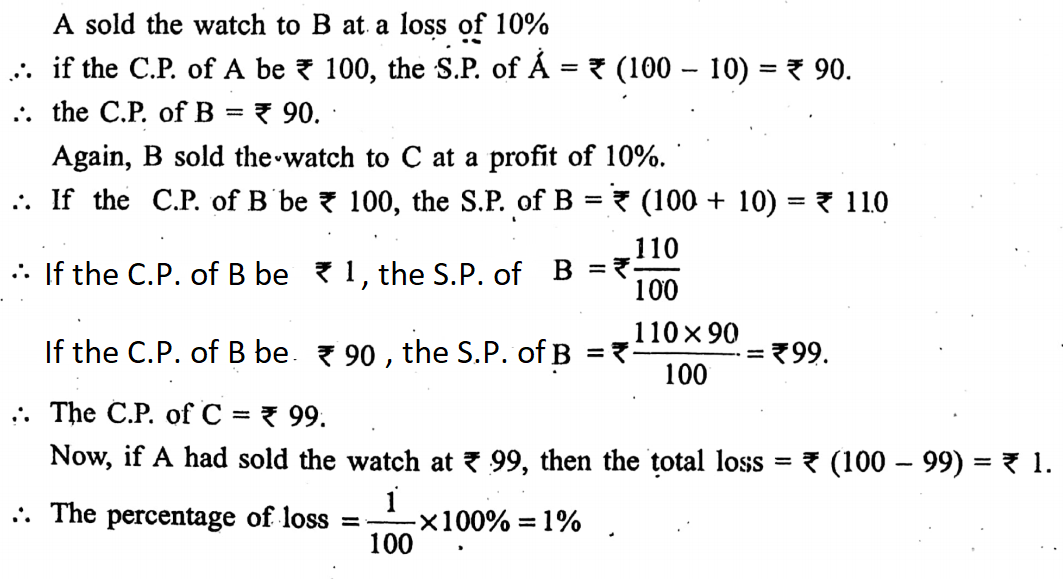
2. By algebraic rule:
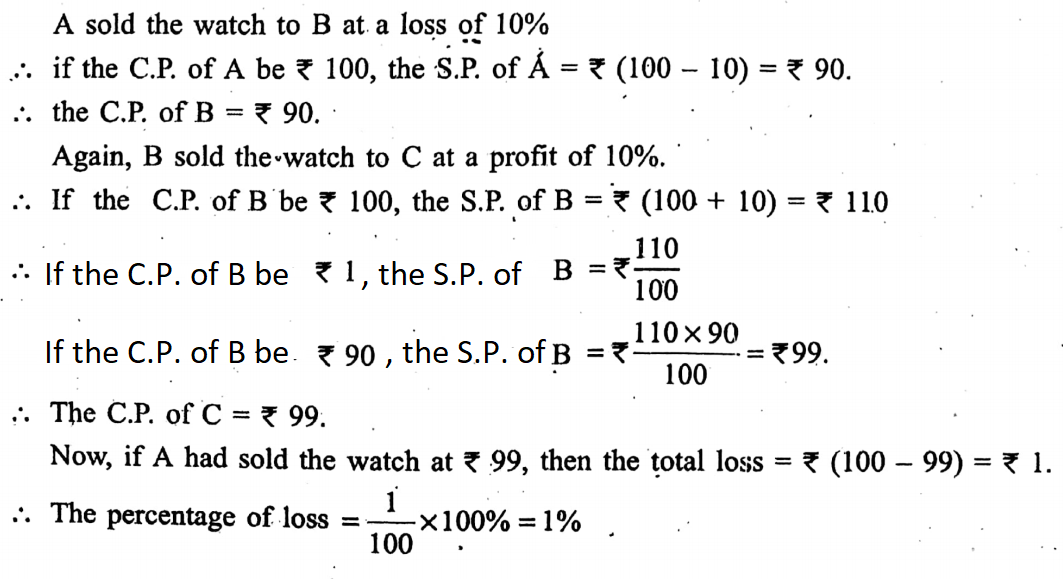
3. By Competitive exam rule (shortcut rule):

Example 15. 10% of the S.P. of an article is equal to 12% of its C.P. and 16% of its S.P. is equal to 6 more than 18% of C.P. Find the C.P. and the S.P. of the article.
Solution:
1. By arithmetic rule:
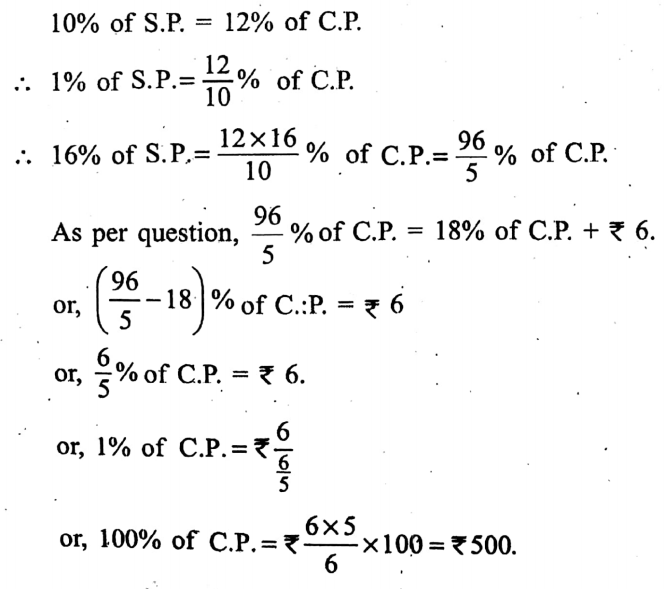
∴ The required C.P. of the article = ₹ 500.
Again, 10% of S.P. 12% of C.P. = ₹500 x \(\frac{12}{100}\)
∴ 1% of S.P. = ₹ \(\frac{60}{10}\)
∴ 100% of S.P. = \(₹ \frac{60 \times 100}{10}\)
= ₹ 600.
∴ The required C.P. ₹ 500 and the required S.P. ₹ 600.
2. By algebraic rule:
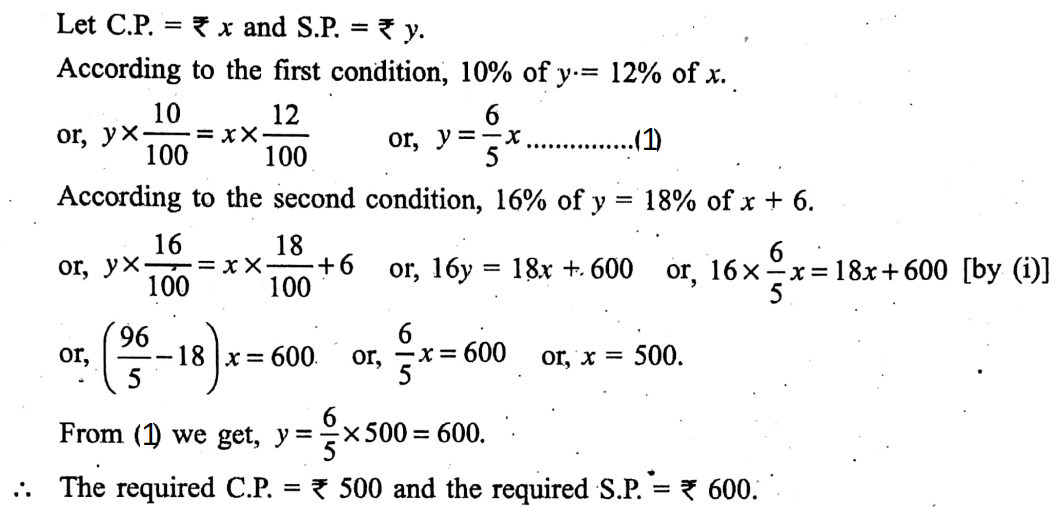
3. By competitive exam rule(Shortcut rule):

Example 16. By selling 40 meters of cloth there is a loss equal to the C.P. of 6 meters of cloth, Find the percentage of loss.
Solution:
1. By arithmetic rule:
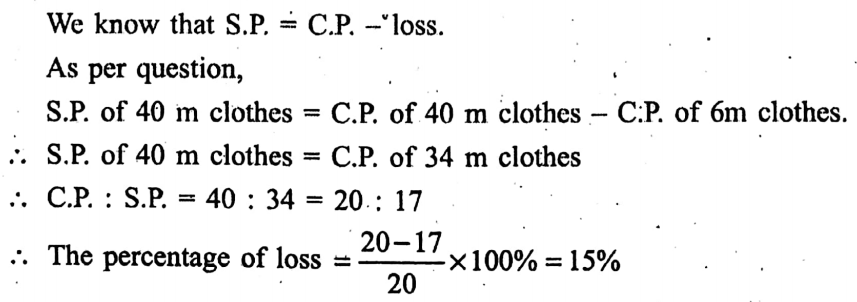
2. By algebraic rule:
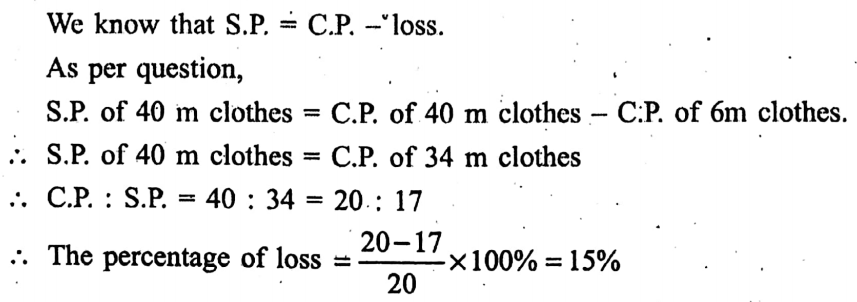
3. By competitive exam rule (shortcut rule):


